Application of Wavelet Methods in the Investigation of Geospace Disturbances: A Review and an Evaluation of the Approach for Quantifying Wavelet Power
Abstract
1. Introduction
- The Quasi-Biennial Oscillation (QBO) of ∼1.3–2 years, which is associated with double peaks of the solar cycle (see review by Hathaway [1]).
2. Theoretical Approach of Time–Frequency Analysis
2.1. Historical Context
2.2. Wavelet Methods
2.2.1. Continuous Wavelet Transform (CWT)
- 1.
- A wavelet must have finite energy, i.e., the integrated squared magnitude of must be less than infinity.
- 2.
- If is the Fourier transform of the wavelet , then must not have a zeroth frequency component ( = 0), i.e., the mean of the wavelet must equal zero. This condition is known as the admissibility constant.
- 3.
- For complex wavelets, the Fourier transform must be both real and vanish for negative frequencies.
2.2.2. Cross Wavelet Transform (XWT) and Wavelet Coherence (WTC)
3. Application of Wavelet Methods
3.1. Application of Wavelet Methods in Large–Scale Periodic Behaviour
3.1.1. Geomagnetic Field
3.1.2. Magnetospheric Particles and Cosmic Rays
- 1.
- The axial effect [65], which is due to the variation of the position of the Earth in heliographic latitude.
- 2.
- The equinoctial effect [66], as a consequence of the varying angle of the Earth’s dipole with respect to the Earth-Sun line.
- 3.
- The Russell and McPherron [59] effect, a result of the larger z component of the interplanetary magnetic field (IMF) near the equinoxes in GSM coordinates, owing to the tilt of the dipole axis relative to the heliographic equatorial plane.
3.2. Application of Wavelet Methods in Short–Scale Periodic Behaviour
3.2.1. Ultra-Low Frequency Waves
3.2.2. Radial Diffusion of the Trapped Electron Population in the Outer Radiation Belt
4. Revisiting the Estimation of Wavelet PSD and Comparison with FFT
5. Summary
Author Contributions
Funding
Institutional Review Board Statement
Informed Consent Statement
Data Availability Statement
Acknowledgments
Conflicts of Interest
Abbreviations
| CHAMP | CHAllenging Minisatellite Payload |
| CIR | Corotating Interaction Region |
| CME | Coronal Mass Ejection |
| COI | Cone of Influence |
| CR | Cosmic Rays |
| CWT | Continuous Wavelet Transform |
| DWT | Discrete Wavelet Transform |
| FFT | Fast Fourier Transform |
| FT | Fourier Transform |
| GCR | Galactic Cosmic Rays |
| GOES | Geostationary Operational Environmental Satellite |
| GSM | Geocentric Solar Magnetospheric |
| GWN | Gaussian White Noise |
| HSSWS | High Speed Solar Wind Stream |
| ICME | Interplanetary Coronal Mass Ejection |
| IMF | Interplanetary Magnetic Field |
| Pc | Pulsation continuous |
| Pi | Pulsation irregular |
| PSD | Power Spectral Density |
| RM | Russell–McPherron |
| SAMPEX | Solar Anomalous and Magnetospheric Particle Explorer |
| SAV | Semi-Annual Variation |
| SIR | Stream Interaction Region |
| SMF | Solar Magnetic Field |
| STFT | Short-Time Fourier Transform |
| ULF | Ultra-Low Frequency |
| WTC | Wavelet Coherence |
| XWT | Cross Wavelet Transform |
| QBO | Quasi-Biennial Oscillation |
References
- Hathaway, D.H. The Solar Cycle. Living Rev. Sol. Phys. 2010, 7, 1–87. [Google Scholar] [CrossRef]
- Rieger, E.; Share, G.H.; Forrest, D.J.; Kanbach, G.; Reppin, C.; Chupp, E.L. A 154-day periodicity in the occurrence of hard solar flares? Nature 1984, 312, 623625. [Google Scholar] [CrossRef]
- Dimitropoulou, M.; Moussas, X.; Strintzi, D. Enhanced Rieger-type periodicities detection in X-ray solar flares and statistical validation of Rossby waves existence. Mon. Not. R. Astron. Soc. 2008, 386, 22782284. [Google Scholar] [CrossRef]
- Polygiannakis, J.; Preka-Papadema, P.; Petropoulos, B.; Pothitakis, G.; Moussas, X.; Pappas, G.; Hillaris, A. Ephemeral periodicities in the solar activity. In SOLMAG 2002, Proceedings of the Magnetic Coupling of the Solar Atmosphere Euroconference, 11–15 June 2002, Santorini, Greece; Sawaya-Lacoste, H., Ed.; ESA Special Publications: Noordwijk, The Netherlands, 2002; Volume 505, pp. 537–540. [Google Scholar]
- Polygiannakis, J.; Preka-Papadema, P.; Moussas, X. On signal-noise decomposition of time-series using the continuous wavelet transform: Application to sunspot index. Mon. Not. R. Astron. Soc. 2003, 343, 725734. [Google Scholar] [CrossRef]
- Gazis, P.R.; Richardson, J.D.; Paularena, K.I. Long term periodicity in solar wind velocity during the last three solar cycles. Geophys. Res. Lett. 1995, 22, 11651168. [Google Scholar] [CrossRef]
- Mursula, K.; Zieger, B. The 13.5-day periodicity in the Sun, solar wind, and geomagnetic activity: The last three solar cycles. J. Geophys. Res. Space Phys. 1996, 101, 2707727090. [Google Scholar] [CrossRef]
- Nayar, S.P.; Radhika, V.; Revathy, K.; Ramadas, V. Wavelet Analysis of solar, solar wind and geomagnetic parameters. Sol. Phys. 2002, 208, 359373. [Google Scholar] [CrossRef]
- Bolzan, M.J.A.; Rosa, R.R.; Ramos, F.M.; Fagundes, P.R.; Sahai, Y. Generalized thermostatistics and wavelet analysis of solar wind and proton density variability. J. Atmos. Sol.-Terr. Phys. 2005, 67, 18431851. [Google Scholar] [CrossRef]
- Katsavrias, C.; Preka-Papadema, P.; Moussas, X. Wavelet Analysis on Solar Wind Parameters and Geomagnetic Indices. Sol. Phys. 2012, 280, 623640. [Google Scholar] [CrossRef]
- Feynman, J. Geomagnetic and solar wind cycles, 1900 1975. J. Geophys. Res. 1982, 87, 6153. [Google Scholar] [CrossRef]
- Du, Z.L. The Solar Cycle: A new prediction technique based on logarithmic values. Astrophys. Space Sci. 2011, 338, 913. [Google Scholar] [CrossRef][Green Version]
- Katsavrias, C.; Hillaris, A.; Preka-Papadema, P. A wavelet based approach to SolarTerrestrial Coupling. Adv. Space Res. 2016, 57, 22342244. [Google Scholar] [CrossRef]
- Valdes-Galicia, J.F.; Perez-Enriquez, R.; Otaola, J.A. The cosmic-ray 1.68-year variation: A clue to understand the nature of the solar cycle? Sol. Phys. 1996, 167, 409417. [Google Scholar] [CrossRef]
- Kudela, K.; Mavromichalaki, H.; Papaioannou, A.; Gerontidou, M. On Mid-Term Periodicities in Cosmic Rays. Sol. Phys. 2010, 266, 173180. [Google Scholar] [CrossRef]
- Addison, P. The little wave with the big future. Phys. World 2004, 17, 3539. [Google Scholar] [CrossRef]
- Balasis, G.; Daglis, I.A.; Kapiris, P.; Mandea, M.; Vassiliadis, D.; Eftaxias, K. From pre-storm activity to magnetic storms: A transition described in terms of fractal dynamics. Ann. Geophys. 2006, 24, 3557–3567. [Google Scholar] [CrossRef]
- Mandea, M.; Balasis, G. The SGR 1806-20 magnetar signature on the Earth’s magnetic field. Geophys. J. Int. 2006, 167, 586–591. [Google Scholar] [CrossRef]
- Balasis, G.; Mandea, M. Can electromagnetic disturbances related to the recent great earthquakes be detected by satellite magnetometers? Tectonophysics 2007, 431, 173–195. [Google Scholar] [CrossRef]
- Kunagu, P.; Balasis, G.; Lesur, V.; Chandrasekhar, E.; Papadimitriou, C. Wavelet characterization of external magnetic sources as observed by CHAMP satellite: Evidence for unmodelled signals in geomagnetic field models. Geophys. J. Int. 2013, 192, 946–950. [Google Scholar] [CrossRef]
- Zaourar, N.; Hamoudi, M.; Mandea, M.; Balasis, G.; Holschneider, M. Wavelet-based multiscale analysis of geomagnetic disturbance. Earth Planets Space 2013, 65, 1525–1540. [Google Scholar] [CrossRef]
- Daubechies, I. Where do wavelets come from? A personal point of view. Proc. IEEE 1996, 84, 510513. [Google Scholar] [CrossRef]
- Farge, M. Wavelet transforms and their applications to turbulence. Annu. Rev. Fluid Mech. 1992, 24, 395–457. [Google Scholar] [CrossRef]
- Strang, G. Wavelet transforms versus Fourier transforms. Bull. Am. Math. Soc. 1993, 28, 288305. [Google Scholar] [CrossRef]
- Lee, D.T.; Yamamoto, A. Wavelet analysis: Theory and applications. Hewlett Packard J. 1994, 45, 4452. [Google Scholar]
- Lau, K.M.; Weng, H. Climate Signal Detection Using Wavelet Transform: How to Make a Time Series Sing. Bull. Am. Meteorol. Soc. 1995, 76, 23912402. [Google Scholar] [CrossRef]
- Graps, A. An introduction to wavelets. IEEE Comput. Sci. Eng. 1995, 2, 5061. [Google Scholar] [CrossRef]
- Akujuobi, C.M. Wavelets and Wavelet Transform Systems and Their Applications; Springer International Publishing: Berlin/Heidelberg, Germany, 2022. [Google Scholar] [CrossRef]
- Fourier, J.B.J. Théorie Analytique de la Chaleur; Chez Firmin Didot, Père et Fils: Paris, France, 1822. [Google Scholar]
- Kumar, P.; Foufoula-Georgiou, E. A multicomponent decomposition of spatial rainfall fields: 1. Segregation of large- and small-scale features using wavelet transforms. Water Resour. Res. 1993, 29, 2515–2532. [Google Scholar] [CrossRef]
- Foufoula-Georgiou, E.; Kumar, P. Wavelet Analysis in Geophysics: An Introduction. In Wavelets in Geophysics; Elsevier: Amsterdam, The Netherlands, 1994; p. 143. [Google Scholar] [CrossRef]
- Gabor, D. Theory of communication. Part 1: The analysis of information. J. Inst. Electr. Eng.-Part III Radio Commun. Eng. 1946, 93, 429441. [Google Scholar] [CrossRef]
- Daubechies, I. The wavelet transform, time–frequency localization and signal analysis. IEEE Trans. Inf. Theory 1990, 36, 9611005. [Google Scholar] [CrossRef]
- Rioul, O.; Vetterli, M. Wavelets and signal processing. IEEE Signal Process. Mag. 1991, 8, 14–36. [Google Scholar] [CrossRef]
- Russell, B.; Han, J. Jean Morlet and the continuous wavelet transform. CREWES Res. Rep. 2016, 28, 115. [Google Scholar]
- Priestley, M.B. Evolutionary Spectra and Non-Stationary Processes. J. R. Stat. Soc. Ser. B (Methodol.) 1965, 27, 204–229. [Google Scholar] [CrossRef]
- Lin, Y.K.; Cai, G.Q. Probabilistic Structural Dynamics; McGraw Hill Higher Education: Maidenhead, UK, 2004. [Google Scholar]
- Spatial Statistics and Digital Image Analysis; National Academies Press: Washington, DC, USA, 1991. [CrossRef]
- Morlet, J.; Arens, G.; Fourgeau, E.; Giard, D. Wave propagation and sampling theory Part II: Sampling theory and complex waves. Geophysics 1982, 47, 222236. [Google Scholar] [CrossRef]
- Addison, P. The Illustrated Wavelet Transform Handbook: Introductory Theory and Applications in Science, Engineering, Medicine and Finance, 2nd ed.; CRC Press: Boca Raton, FL, USA, 2017. [Google Scholar] [CrossRef]
- Torrence, C.; Compo, G.P. A Practical Guide to Wavelet Analysis. Bull. Am. Meteorol. Soc. 1998, 79, 61–78. [Google Scholar] [CrossRef]
- Torrence, C.; Webster, P.J. Interdecadal Changes in the ENSO-Monsoon System. J. Clim. 1999, 12, 2679–2690. [Google Scholar] [CrossRef]
- Kantelhardt, J.W. Fractal and Multifractal Time Series. In Encyclopedia of Complexity and Systems Science; Meyers, R.A., Ed.; Springer: New York, NY, USA, 2009; p. 37543779. [Google Scholar] [CrossRef]
- Kaiser, G. A Friendly Guide to Wavelets; Birkhäuser: Boston, MA, USA, 2011. [Google Scholar] [CrossRef]
- Astaf’eva, N.M. Wavelet analysis: Basic theory and some applications. Physics-Uspekhi 1996, 39, 10851108. [Google Scholar] [CrossRef]
- Novikov, I.Y.; Stechkin, S.B. Basic wavelet theory. Russ. Math. Surv. 1998, 53, 11591231. [Google Scholar] [CrossRef]
- Morlet, J. Sampling Theory and Wave Propagation. In Issues in Acoustic Signal Image Processing and Recognition; Springer: Berlin/Heidelberg, Germany, 1983; p. 233261. [Google Scholar] [CrossRef]
- Ashmead, J. Morlet Wavelets in Quantum Mechanics. Quanta 2012, 1, 5870. [Google Scholar] [CrossRef]
- Grinsted, A.; Moore, J.C.; Jevrejeva, S. Application of the cross wavelet transform and wavelet coherence to geophysical time series. Nonlinear Process. Geophys. 2004, 11, 561–566. [Google Scholar] [CrossRef]
- Kumar, P.; Foufoula-Georgiou, E. Wavelet analysis for geophysical applications. Rev. Geophys. 1997, 35, 385412. [Google Scholar] [CrossRef]
- Tsichla, M.; Gerontidou, M.; Mavromichalaki, H. Spectral Analysis of Solar and Geomagnetic Parameters in Relation to Cosmic-ray Intensity for the Time Period 1965–2018. Sol. Phys. 2019, 294, 15. [Google Scholar] [CrossRef]
- Maraun, D.; Kurths, J. Cross wavelet analysis: Significance testing and pitfalls. Nonlinear Process. Geophys. 2004, 11, 505–514. [Google Scholar] [CrossRef]
- Mayaud, P.N. Derivation, Meaning, and Use of Geomagnetic Indices. Wash. Am. Geophys. Union Geophys. Monogr. Ser. 1980, 22, 607. [Google Scholar] [CrossRef]
- Menvielle, M.; Iyemori, T.; Marchaudon, A.; Nosé, M. Geomagnetic Indices. In Geomagnetic Observations and Models; Springer: Dordrecht, The Netherlands, 2010; p. 183228. [Google Scholar] [CrossRef]
- Bartels, J. Discussion of time-variations of geomagnetic activity, indices Kp and Ap, 1932–1961. Ann. Geophys. 1963, 19, 1. [Google Scholar]
- Fraser-Smith, A.C. Spectrum of the geomagnetic activity indexAp. J. Geophys. Res. 1972, 77, 42094220. [Google Scholar] [CrossRef]
- Singh, Y.; Badruddin. Short- and mid-term oscillations of solar, geomagnetic activity and cosmic-ray intensity during the last two solar magnetic cycles. Planet. Space Sci. 2017, 138, 16. [Google Scholar] [CrossRef]
- Lou, Y.Q.; Wang, Y.M.; Fan, Z.; Wang, S.; Wang, J.X. Periodicities in solar coronal mass ejections. Mon. Not. R. Astron. Soc. 2003, 345, 809818. [Google Scholar] [CrossRef]
- Russell, C.T.; McPherron, R.L. Semi-annual variation of geomagnetic activity. J. Geophys. Res. 1973, 78, 92108. [Google Scholar] [CrossRef]
- Ou, J.; Du, A.; Finlay, C.C. Quasi-biennial oscillations in the geomagnetic field: Their global characteristics and origin. J. Geophys. Res. Space Phys. 2017, 122, 50435058. [Google Scholar] [CrossRef]
- El-Borie, M.A.; El-Taher, A.M.; Thabet, A.A.; Bishara, A.A. The Dependence of Solar, Plasma, and Geomagnetic Parameters’ Oscillations on the Heliospheric Magnetic Field Polarities: Wavelet Analysis. Astrophys. J. 2019, 880, 86. [Google Scholar] [CrossRef]
- El-Taher, A.; Thabet, A. The interconnection and phase asynchrony between the geomagnetic indices’ periodicities: A study based on the interplanetary magnetic field polarities 1967–2018 utilizing a cross wavelet analysis. Adv. Space Res. 2021, 67, 32133227. [Google Scholar] [CrossRef]
- Andriyas, T.; Andriyas, S. Periodicities in solar wind-magnetosphere coupling functions and geomagnetic activity during the past solar cycles. Astrophys. Space Sci. 2017, 362. [Google Scholar] [CrossRef]
- Baker, D.N.; Kanekal, S.G.; Pulkkinen, T.I.; Blake, J.B. Equinoctial and solstitial averages of magnetospheric relativistic electrons: A strong semiannual modulation. Geophys. Res. Lett. 1999, 26, 31933196. [Google Scholar] [CrossRef]
- Svalgaard, L. Geomagnetic activity: Dependence on solar wind parameters. In Coronal Holes and High Speed Wind Streams; Zirker, J.B., Ed.; Stanford Univ Calif Inst For Plasma Research: Stanford, CA, USA, 1977; pp. 371–441. [Google Scholar]
- Cliver, E.W.; Kamide, Y.; Ling, A.G. Mountains versus valleys: Semiannual variation of geomagnetic activity. J. Geophys. Res. Space Phys. 2000, 105, 24132424. [Google Scholar] [CrossRef]
- Katsavrias, C.; Papadimitriou, C.; Aminalragia-Giamini, S.; Daglis, I.A.; Sandberg, I.; Jiggens, P. On the semi-annual variation of relativistic electrons in the outer radiation belt. Ann. Geophys. 2021, 39, 413425. [Google Scholar] [CrossRef]
- Poblet, F.L.; Azpilicueta, F.; Lam, H.L. Semi-annual variation in relativistic electron fluxes of the outer radiation belt: Phases comparison with classical hypotheses predictions. Adv. Space Res. 2021, 68, 170181. [Google Scholar] [CrossRef]
- Katsavrias, C.; Aminalragia-Giamini, S.; Papadimitriou, C.; Daglis, I.A.; Sandberg, I.; Jiggens, P. Radiation Belt Model Including Semi-Annual Variation and Solar Driving (Sentinel). Space Weather 2022, 20, e2021SW002936. [Google Scholar] [CrossRef]
- Mavromichalaki, H.; Preka-Papadema, P.; Petropoulos, B.; Tsagouri, I.; Georgakopoulos, S.; Polygiannakis, J. Low- and high-frequency spectral behavior of cosmic-ray intensity for the period 1953–1996. Ann. Geophys. 2003, 21, 16811689. [Google Scholar] [CrossRef]
- Kudela, K.; Rybák, J.; Antalová, A.; Storini, M. Time evolution of low-frequency periodicities in cosmic ray intensity. Sol. Phys. 2002, 205, 165175. [Google Scholar] [CrossRef]
- Chowdhury, P.; Kudela, K.; Moon, Y.J. A Study of Heliospheric Modulation and Periodicities of Galactic Cosmic Rays during Cycle 24. Sol. Phys. 2016, 291, 581602. [Google Scholar] [CrossRef]
- Daglis, I.A.; Katsavrias, C.; Georgiou, M. From solar sneezing to killer electrons: Outer radiation belt response to solar eruptions. Philos. Trans. R. Soc. Lond. Ser. A 2019, 377, 20180097. [Google Scholar] [CrossRef] [PubMed]
- Elkington, S.R. Resonant acceleration and diffusion of outer zone electrons in an asymmetric geomagnetic field. J. Geophys. Res. 2003, 108. [Google Scholar] [CrossRef]
- Katsavrias, C.; Daglis, I.A.; Li, W.; Dimitrakoudis, S.; Georgiou, M.; Turner, D.L.; Papadimitriou, C. Combined effects of concurrent Pc5 and chorus waves on relativistic electron dynamics. Ann. Geophys. 2015, 33, 11731181. [Google Scholar] [CrossRef]
- Georgiou, M.; Daglis, I.A.; Zesta, E.; Balasis, G.; Mann, I.R.; Katsavrias, C.; Tsinganos, K. Association of radiation belt electron enhancements with earthward penetration of Pc5 ULF waves: A case study of intense 2001 magnetic storms. Ann. Geophys. 2015, 33, 14311442. [Google Scholar] [CrossRef]
- Jaynes, A.N.; Ali, A.F.; Elkington, S.R.; Malaspina, D.M.; Baker, D.N.; Li, X.; Kanekal, S.G.; Henderson, M.G.; Kletzing, C.A.; Wygant, J.R. Fast Diffusion of Ultrarelativistic Electrons in the Outer Radiation Belt: 17 March 2015 Storm Event. Geophys. Res. Lett. 2018, 45, 10874–10882. [Google Scholar] [CrossRef]
- Katsavrias, C.; Sandberg, I.; Li, W.; Podladchikova, O.; Daglis, I.; Papadimitriou, C.; Tsironis, C.; Aminalragia-Giamini, S. Highly Relativistic Electron Flux Enhancement During the Weak Geomagnetic Storm of April May 2017. J. Geophys. Res. Space Phys. 2019, 124, 44024413. [Google Scholar] [CrossRef]
- Nasi, A.; Daglis, I.; Katsavrias, C.; Li, W. Interplay of source/seed electrons and wave-particle interactions in producing relativistic electron PSD enhancements in the outer Van Allen belt. J. Atmos. Sol.-Terr. Phys. 2020, 210, 105405. [Google Scholar] [CrossRef]
- Turner, D.L.; Shprits, Y.; Hartinger, M.; Angelopoulos, V. Explaining sudden losses of outer radiation belt electrons during geomagnetic storms. Nat. Phys. 2012, 8, 208212. [Google Scholar] [CrossRef]
- Katsavrias, C.; Daglis, I.A.; Turner, D.L.; Sandberg, I.; Papadimitriou, C.; Georgiou, M.; Balasis, G. Nonstorm loss of relativistic electrons in the outer radiation belt. Geophys. Res. Lett. 2015, 42, 10521–10530. [Google Scholar] [CrossRef]
- Katsavrias, C.; Daglis, I.A.; Li, W. On the Statistics of Acceleration and Loss of Relativistic Electrons in the Outer Radiation Belt: A Superposed Epoch Analysis. J. Geophys. Res. Space Phys. 2019, 124, 2755–2768. [Google Scholar] [CrossRef]
- Anderson, B.J.; Erlandson, R.E.; Zanetti, L.J. A statistical study of Pc 1-2 magnetic pulsations in the equatorial magnetosphere: 2. Wave properties. J. Geophys. Res. Space Phys. 1992, 97, 30893101. [Google Scholar] [CrossRef]
- Loto’Aniu, T.M.; Fraser, B.J.; Waters, C.L. Propagation of electromagnetic ion cyclotron wave energy in the magnetosphere. J. Geophys. Res. (Space Phys.) 2005, 110, A07214. [Google Scholar] [CrossRef]
- Balasis, G.; Daglis, I.A.; Zesta, E.; Papadimitriou, C.; Georgiou, M.; Haagmans, R.; Tsinganos, K. ULF wave activity during the 2003 Halloween superstorm: Multipoint observations from CHAMP, Cluster and Geotail missions. Ann. Geophys. 2012, 30, 17511768. [Google Scholar] [CrossRef]
- Heilig, B.; Lühr, H.; Rother, M. Comprehensive study of ULF upstream waves observed in the topside ionosphere by CHAMP and on the ground. Ann. Geophys. 2007, 25, 737754. [Google Scholar] [CrossRef]
- Balasis, G.; Daglis, I.A.; Georgiou, M.; Papadimitriou, C.; Haagmans, R. Magnetospheric ULF wave studies in the frame of Swarm mission: A time–frequency analysis tool for automated detection of pulsations in magnetic and electric field observations. Earth Planets Space 2013, 65, 13851398. [Google Scholar] [CrossRef]
- Balasis, G.; Aminalragia-Giamini, S.; Papadimitriou, C.; Daglis, I.A.; Anastasiadis, A.; Haagmans, R. A machine learning approach for automated ULF wave recognition. J. Space Weather Space Clim. 2019, 9, A13. [Google Scholar] [CrossRef]
- Papadimitriou, C.; Balasis, G.; Daglis, I.A.; Giannakis, O. An initial ULF wave index derived from 2 years of Swarm observations. Ann. Geophys. 2018, 36, 287299. [Google Scholar] [CrossRef]
- Nosé, M.; Iyemori, T.; Takeda, M.; Kamei, T.; Milling, D.K.; Orr, D.; Singer, H.J.; Worthington, E.W.; Sumitomo, N. Automated detection of Pi 2 pulsations using wavelet analysis: 1. Method and an application for substorm monitoring. Earth Planets Space 1998, 50, 773783. [Google Scholar] [CrossRef]
- Murphy, K.R.; Rae, I.J.; Mann, I.R.; Milling, D.K.; Watt, C.E.J.; Ozeke, L.; Frey, H.U.; Angelopoulos, V.; Russell, C.T. Wavelet-based ULF wave diagnosis of substorm expansion phase onset. J. Geophys. Res. Space Phys. 2009, 114. [Google Scholar] [CrossRef]
- Archer, M.O.; Horbury, T.S.; Eastwood, J.P.; Weygand, J.M.; Yeoman, T.K. Magnetospheric response to magnetosheath pressure pulses: A low-pass filter effect. J. Geophys. Res. Space Phys. 2013, 118, 54545466. [Google Scholar] [CrossRef]
- Archer, M.O.; Hartinger, M.D.; Horbury, T.S. Magnetospheric ’magic’ frequencies as magnetopause surface eigenmodes. Geophys. Res. Lett. 2013, 40, 50035008. [Google Scholar] [CrossRef]
- Katsavrias, C.; Raptis, S.; Daglis, I.A.; Karlsson, T.; Georgiou, M.; Balasis, G. On the Generation of Pi2 Pulsations due to Plasma Flow Patterns Around Magnetosheath Jets. Geophys. Res. Lett. 2021, 48, e2021GL093611. [Google Scholar] [CrossRef]
- Fei, Y.; Chan, A.A.; Elkington, S.R.; Wiltberger, M.J. Radial diffusion and MHD particle simulations of relativistic electron transport by ULF waves in the September 1998 storm. J. Geophys. Res. 2006, 111. [Google Scholar] [CrossRef]
- Dimitrakoudis, S.; Mann, I.R.; Balasis, G.; Papadimitriou, C.; Anastasiadis, A.; Daglis, I.A. Accurately specifying storm-time ULF wave radial diffusion in the radiation belts. Geophys. Res. Lett. 2015, 42, 57115718. [Google Scholar] [CrossRef]
- Liu, W.; Tu, W.; Li, X.; Sarris, T.; Khotyaintsev, Y.; Fu, H.; Zhang, H.; Shi, Q. On the calculation of electric diffusion coefficient of radiation belt electrons with in situ electric field measurements by THEMIS. Geophys. Res. Lett. 2016, 43, 10231030. [Google Scholar] [CrossRef]
- Sandhu, J.K.; Rae, I.J.; Wygant, J.R.; Breneman, A.W.; Tian, S.; Watt, C.E.J.; Horne, R.B.; Ozeke, L.G.; Georgiou, M.; Walach, M.T. ULF Wave Driven Radial Diffusion during Geomagnetic Storms: A Statistical Analysis of Van Allen Probes Observations. J. Geophys. Res. Space Phys. 2021, 126, e2020JA029024. [Google Scholar] [CrossRef]
- Dimitrakoudis, S.; Mann, I.R.; Balasis, G.; Papadimitriou, C.; Anastasiadis, A.; Daglis, I.A. On the Interplay Between Solar Wind Parameters and ULF Wave Power as a Function of Geomagnetic Activity at High- and Mid-latitudes. J. Geophys. Res. Space Phys. 2021, 127, e2021JA029693. [Google Scholar] [CrossRef]
- Katsavrias, C.; Nasi, A.; Daglis, I.A.; Aminalragia-Giamini, S.; Dahmen, N.; Papadimitriou, C.; Georgiou, M.; Brunet, A.; Bourdarie, S. The “SafeSpace” Radial Diffusion Coefficients Database: Dependencies and application to simulations. Ann. Geophys. Discuss. 2021. [Google Scholar] [CrossRef]
- Liang, X.S.; Robinson, A.R. Localized multiscale energy and vorticity analysis. Dyn. Atmos. Ocean. 2005, 38, 195230. [Google Scholar] [CrossRef]
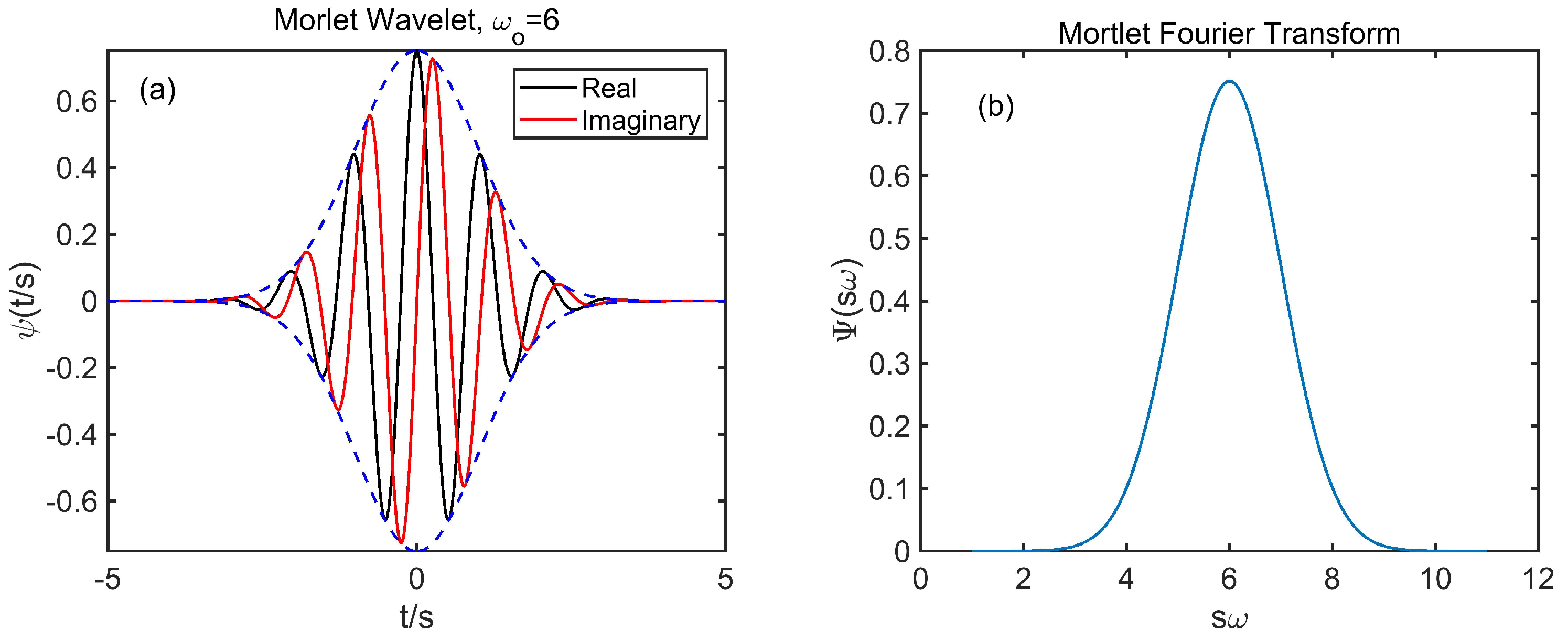
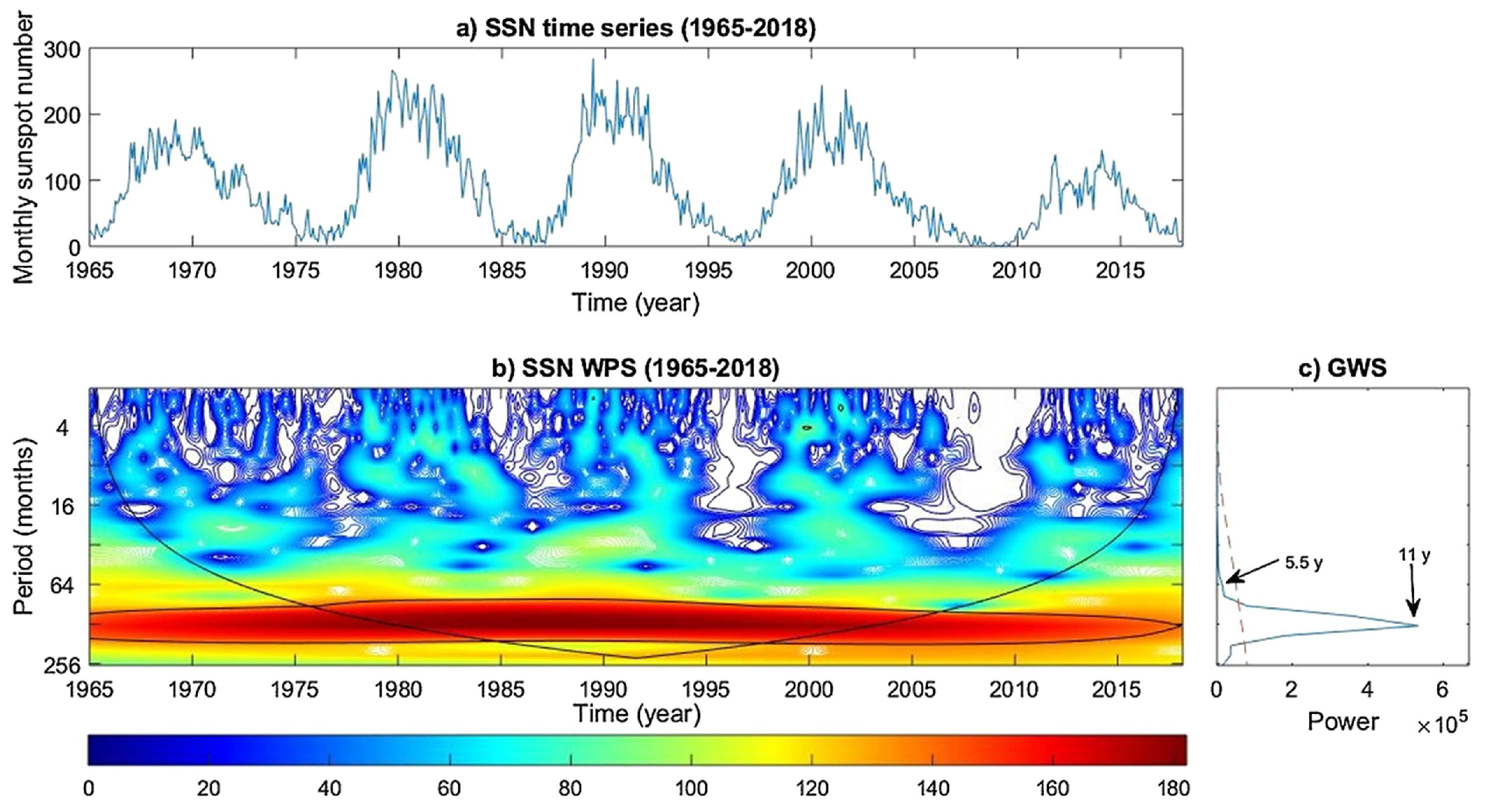
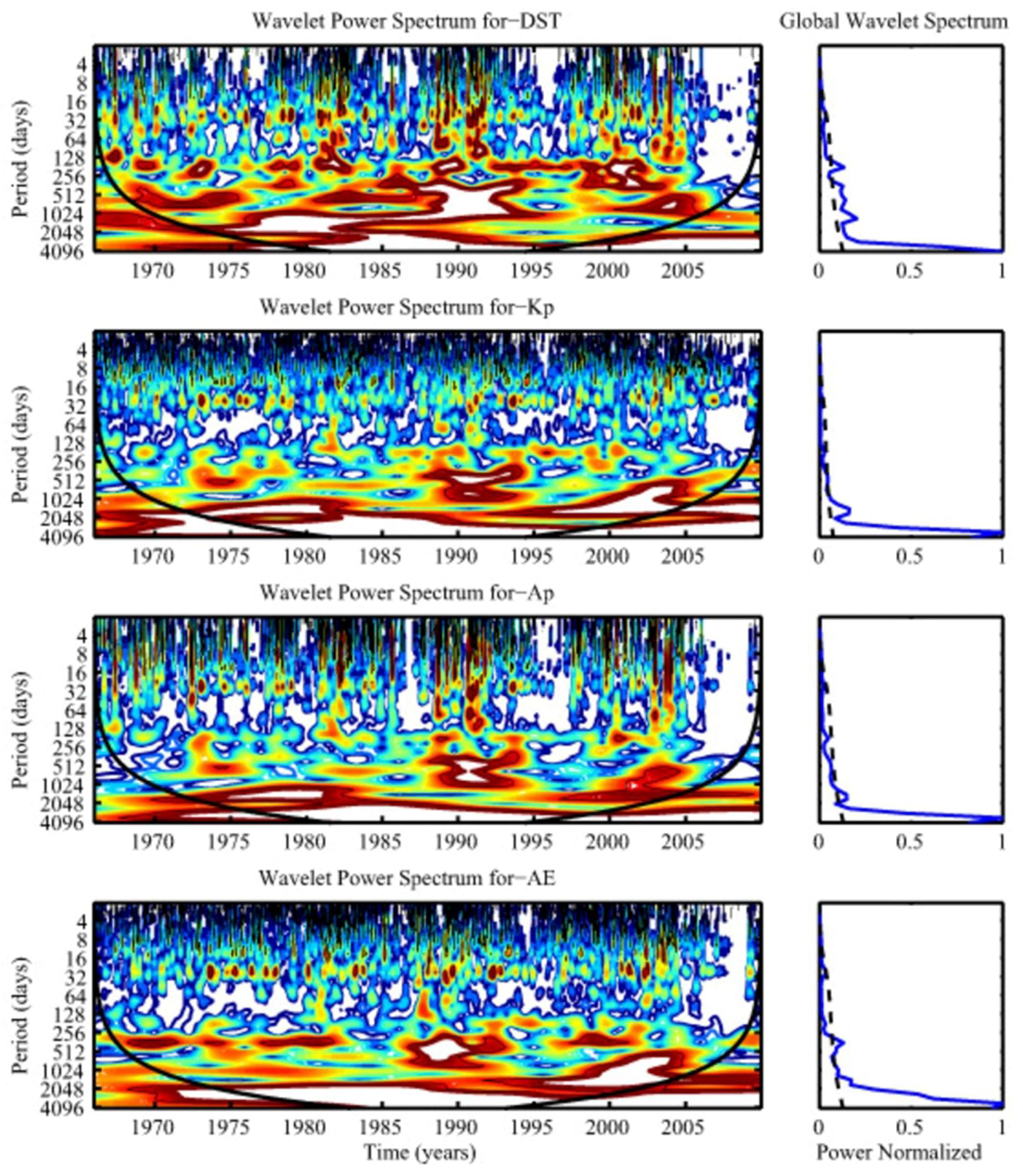
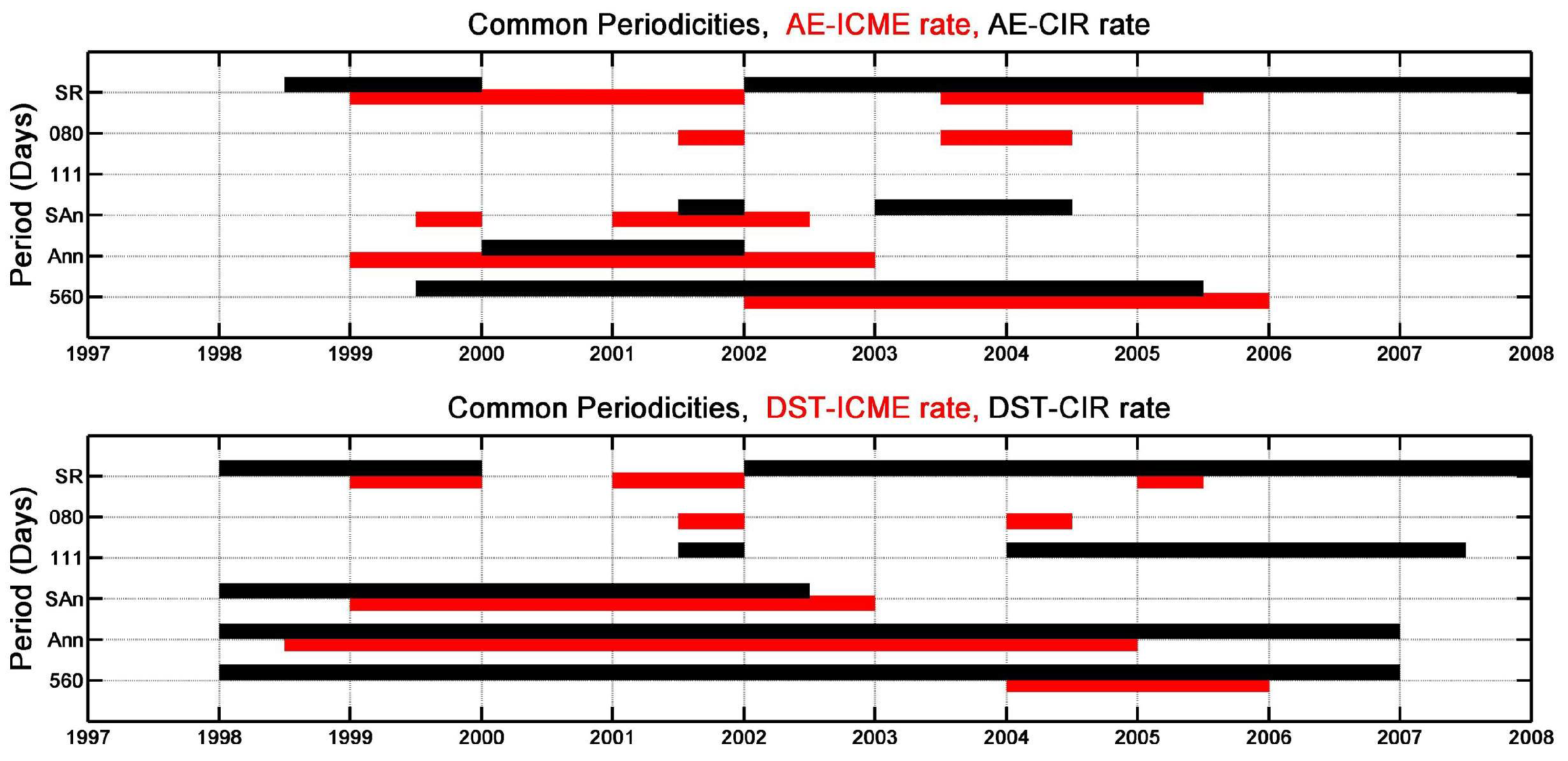
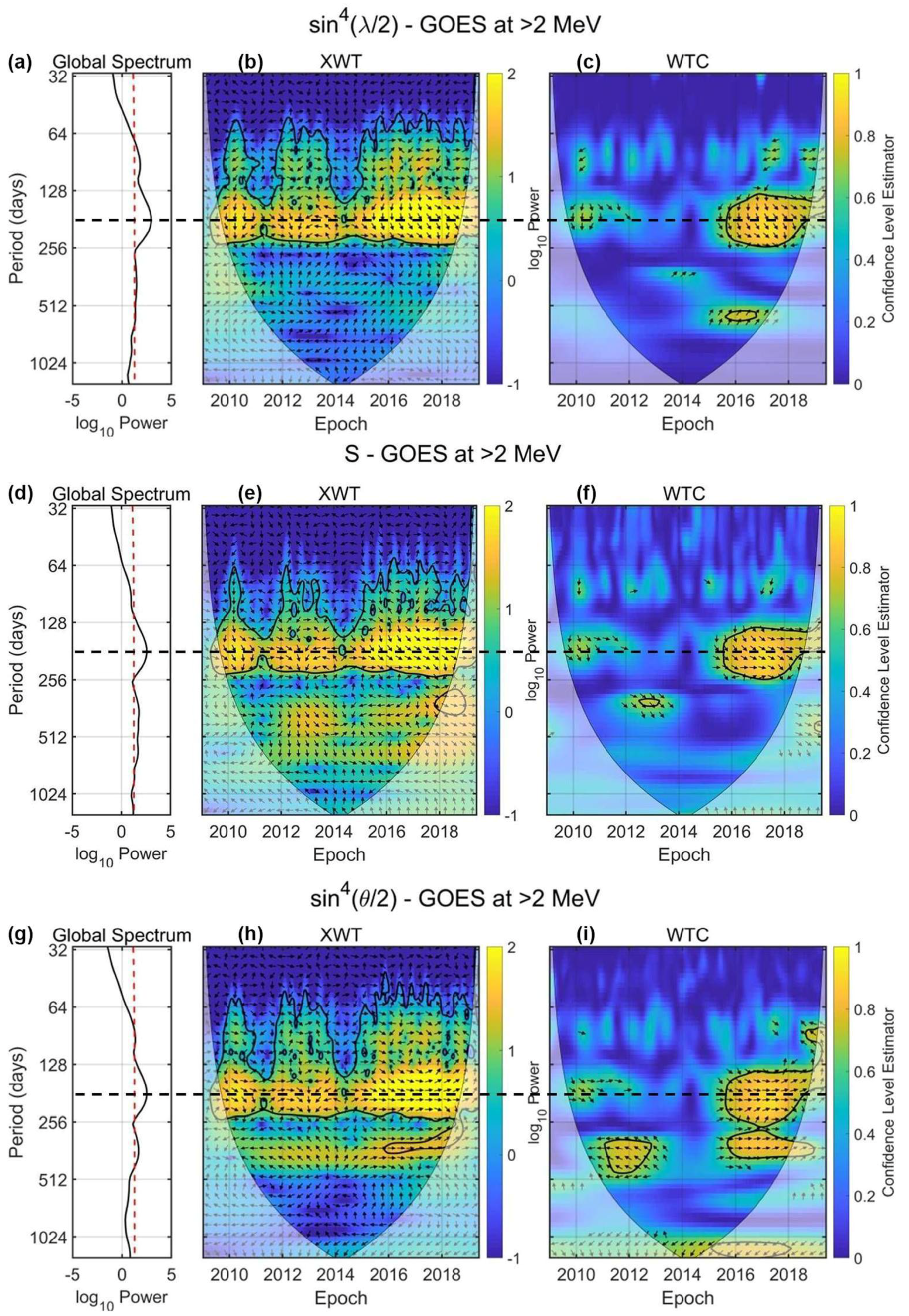

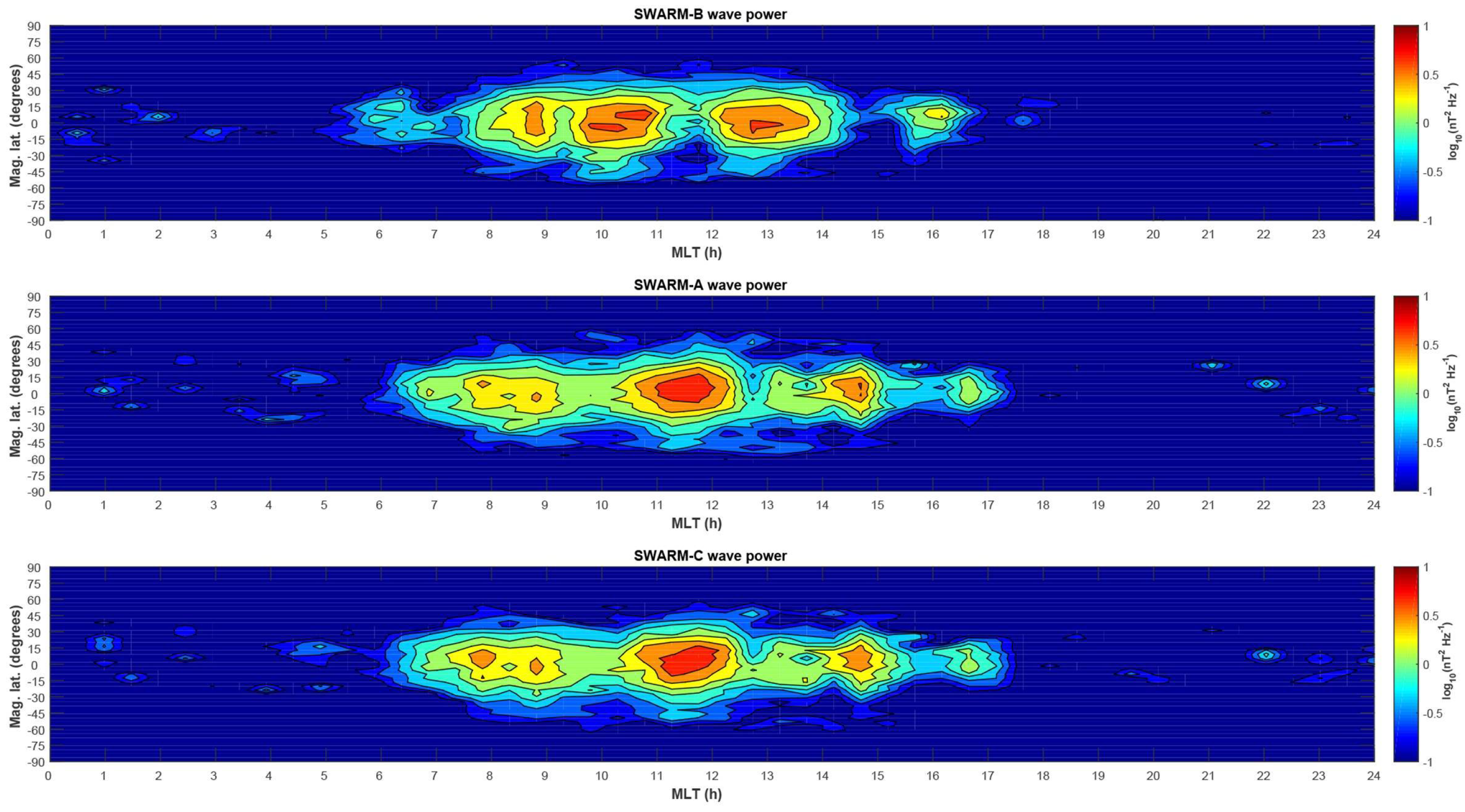
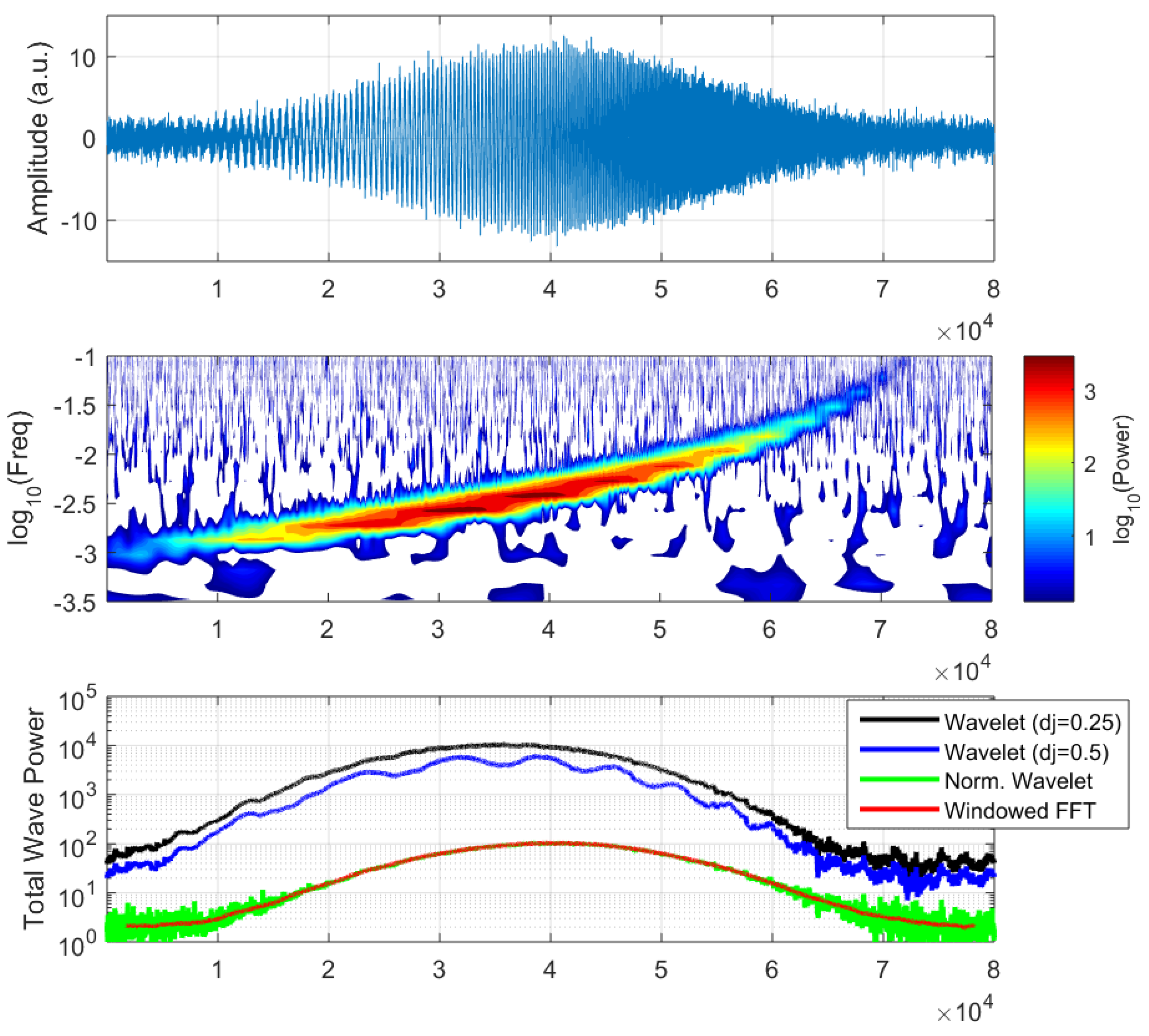
Publisher’s Note: MDPI stays neutral with regard to jurisdictional claims in published maps and institutional affiliations. |
© 2022 by the authors. Licensee MDPI, Basel, Switzerland. This article is an open access article distributed under the terms and conditions of the Creative Commons Attribution (CC BY) license (https://creativecommons.org/licenses/by/4.0/).
Share and Cite
Katsavrias, C.; Papadimitriou, C.; Hillaris, A.; Balasis, G. Application of Wavelet Methods in the Investigation of Geospace Disturbances: A Review and an Evaluation of the Approach for Quantifying Wavelet Power. Atmosphere 2022, 13, 499. https://doi.org/10.3390/atmos13030499
Katsavrias C, Papadimitriou C, Hillaris A, Balasis G. Application of Wavelet Methods in the Investigation of Geospace Disturbances: A Review and an Evaluation of the Approach for Quantifying Wavelet Power. Atmosphere. 2022; 13(3):499. https://doi.org/10.3390/atmos13030499
Chicago/Turabian StyleKatsavrias, Christos, Constantinos Papadimitriou, Alexandros Hillaris, and Georgios Balasis. 2022. "Application of Wavelet Methods in the Investigation of Geospace Disturbances: A Review and an Evaluation of the Approach for Quantifying Wavelet Power" Atmosphere 13, no. 3: 499. https://doi.org/10.3390/atmos13030499
APA StyleKatsavrias, C., Papadimitriou, C., Hillaris, A., & Balasis, G. (2022). Application of Wavelet Methods in the Investigation of Geospace Disturbances: A Review and an Evaluation of the Approach for Quantifying Wavelet Power. Atmosphere, 13(3), 499. https://doi.org/10.3390/atmos13030499







